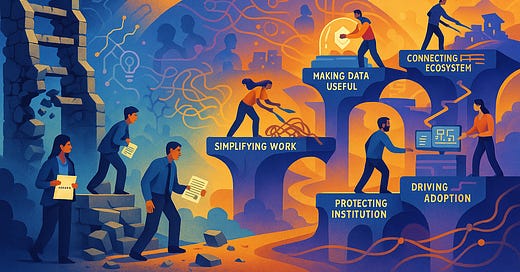Recap: If the Ladder Breaks, Build a Map
What the new job market demands and how we must prepare students to excel in it.
The New York Times stirred up a discussion this past week with a story about recent computer science graduates struggling to find work. The article (“Goodbye, $165,000 Tech Jobs. Student Coders Seek Work at Chipotle”) highlights stories of students sending out thousands of applications, getting instant rejections, or only landing interviews for non-technical roles. It points to AI tools and tech layoffs as reducing the shrinking pool of entry-level jobs, with some settling for customer service or sales roles despite holding technical degrees. The piece struck a nerve, but it also raised questions about how representative these anecdotes are of the broader labor market.
As I began teaching a course of graduate and MBA students this week, the future job market I’m helping to prepare them for has been top of my mind.
I don’t doubt that a handful of computer science graduates from elite programs once landed $165,000 software engineering jobs. But let’s be honest, those roles were almost certainly extensions of multi-year internships or highly selective return offers from big tech firms. They’ve always been rare. Even before ChatGPT, those jobs were reserved for the top fraction of graduates with strong networks, glowing referrals, and sustained experience. What’s new isn’t that most grads didn’t land those jobs. It’s that the fallback pathways, moderate-paying entry roles at midsize firms or startups, have narrowed as well, especially for those without prior internships or standout portfolios.
What the Times captured in anecdote, recent data confirms: AI is not triggering mass layoffs, but it is quietly hollowing out the entry-level. As I wrote earlier this summer, the real shift isn’t a “white-collar bloodbath,” it’s a reclassification of value. AI doesn’t eliminate jobs evenly; it erodes roles and routines, especially narrow, repetitive ones. The roles rising in value: integrators, orchestrators, and strategic synthesizers, require judgment, emotional intelligence, and the ability to collaborate across teams and tools. Our curricula, capstones, and advising structures need to reflect this new reality. Not just so our students get hired, but so they stay relevant once they do
The Jobs That Will Rise
If AI is quietly hollowing out the lower rungs of the career ladder, it’s also elevating a new class of roles that require not just technical fluency, but human versatility. These aren’t jobs that compete with AI; they’re the ones that make AI usable, trusted, and transformative across institutions. I see these roles taking shape across five key arenas and these are exactly the capacities we must prepare our students to lead in.
Simplifying Work: The ability to streamline complex, legacy processes is no longer a back-office function; it’s frontline leadership. As systems grow more automated, the differentiator is human clarity: people who can remove friction, not just encode it. This requires systems thinking, empathy, and collaboration across units.
Protecting the Institution: Cybersecurity has evolved into a trust function. Those who can bridge technical knowledge with institutional credibility, who can explain threats calmly, navigate crises, and build resilient policy, will become essential stewards of reputation and continuity.
Making Data Useful: The glut of dashboards doesn’t mean insight is automatic. Institutions need integrators who can turn scattered data into shared language, build usable systems, and lead cultural shifts in how decisions get made. This is less about data engineering and more about interpretive leadership.
Connecting the Ecosystem: Integration today means aligning people as much as APIs. It calls for cross-functional thinkers who can translate between departments, vendors, and platforms. In an environment full of fragmentation, this glue work is not administrative; it’s strategic.
Driving Adoption That Sticks: Technology doesn’t transform institutions. People do. The real challenge lies not in procurement but in helping teams adopt, adapt, and embed new tools into their daily rhythms. The leaders who will thrive here are those who can guide change patiently and persistently over time.
These are not roles that can be filled by narrow expertise or rigid scripts. They require flexibility, systems-level thinking, and emotional intelligence. They are the very definition of high-versatility, high-value work, and they are precisely what I aim to prepare my students for. AI will keep evolving. So must we. Let’s train not just coders or analysts, but adaptive leaders who navigate ambiguity to make organizations better.
From Scarcity to Shift
The tech job market may be tighter, but the shift is more significant than scarcity. Roles that relied on repetition and rigid specialization are vanishing, while those that demand adaptability, judgment, and cross-system connections are emerging. These roles thrive in AI and shape its use. Institutions and programs that embrace this shift, build versatility, embed AI fluency, and teach students to lead through complexity will not only place more graduates but will define meaningful work in the AI era.



